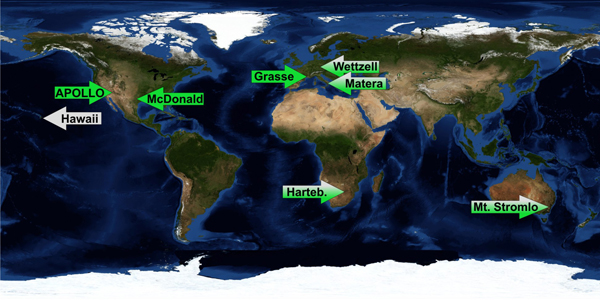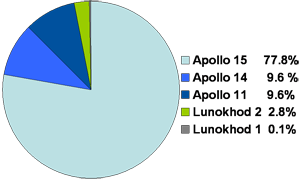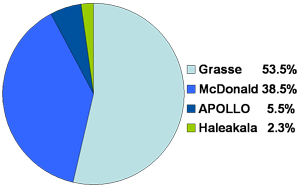Lunar Laser Ranging (LLR)
Science
During three U.S. Apollo missions (11, 14, and 15) and two unmanned Soviet missions (Luna 17 and Luna 21), retro-reflectors were deployed near the landing sites between 1969 and 1973 (Figure 1). The LLR experiment has continuously provided range data for about 41 years, generating about 17000 normal points (Figure 2). The main benefit of this space geodetic technique is the determination of a host of parameters describing lunar ephemeris, lunar physics, the Moon’s interior, various reference frames, Earth orientation parameters and the Earth-Moon dynamics [2, 4]. LLR has also become one of the strongest tools for testing Einstein's theory of general relativity in the solar system; no violations of general relativity have been found so far [1,3, 4]. However, the basis for all scientific analyses is more high quality data from a well-distributed global LLR network.
Of all of the ILRS observatories (nearly 40), only a few sites that are technically equipped to carry out Lunar Laser Ranging (LLR) to retro-reflector arrays on the surface of the Moon (Figure 3).

Figure 3. ILRS observatories carrying out Lunar Laser Ranging (LLR) to retro-reflector arrays on the surface of the Moon
The McDonald Observatory in Texas, USA, the Apache Point Observatory, New Mexico, USA, and the Observatoire de la Côte d’ Azur, France are the only currently operational LLR sites. The latter has undergone renovation since late 2004, and returned to action in September 2009. The McDonald observatory has major problems to get further LLR tracking funded. Although no system upgrade could be made in the past years, lunar tracking could be continued at a certain level. The new site with lunar capability at the Apache Point Observatory, New Mexico, USA, is equipped with a 3.5 m telescope. This station, called APOLLO, is designed for mm accuracy ranging. Until end of 2010, a set of data from APOLLO was released with a total of ~940 normal points. The data are now available in the newly adopted ILRS CRD data format through a reformatting effort at the McDonald Observatory. The measurement statistics of the major lunar observatories between 1970 and 2011 is shown in Figure 4.
Also other modern stations have demonstrated lunar capability, e.g., the Matera Laser Ranging Station, Italy in 2010, but all of them suffer from technical problems or funding restrictions. The Wettzell observatory, Germany, plans to soon resume lunar tracking. The Australian station at Mt. Stromlo is expected to join this group in the future, and there are plans for establishing lunar capability at the South African site of Hartebeesthoek.
Prediction and Validation of LLR normal points
At the Observatoire de Paris, an "assisting tool" has been developed to support lunar tracking by providing predictions of future LLR observations as well as a validation of past LLR normal points.
Active observatories
- APOLLO, New Mexico, USA
- McDonald Observatory, Texas, USA
- Observatoire de la Côte d’ Azur, France
Future and former observatories
- Matera Laser Ranging Observatory, Italy
- Geodetic Observatory Wettzell
- Mount Stromlo Satellite Laser Ranging Observatory
- Hartebeesthoek Radio Astronomy Observatory
- LURE Observatory, Hawaii (former observatory)
Reflectors on Moon
- U.S. - Apollo 11, Apollo 14, Apollo 15
- Russia: Lunokhod 1 (re-discovered in 2010), Lunokhod 2
Analysis Groups
Web Resources
- Lunar Laser Ranging Service (predictions for future observations and validation of past observations)
- Lunokhod-2 Azimuth Limits
- All available LLR data gathered by POLAC (1969-2013)
- ILRS email exploder: ilrs-llr @ lists.nasa.gov
Literature
- Müller, J., Hofmann, F., Fang, X., Biskupek, L. (2013): Lunar Laser Ranging: recent results based on refined modelling., In: Earth on the Edge: Science for a Sustainable Planet (eds. C. Rizos, P. Willis). IAG Symposia Series, Vol. 139, Springer 2013.
- Biskupek, L., Müller, J., Hofmann, F. (2012): Determination of Nutation Coefficients from Lunar Laser Ranging, In: Geodesy for Planet Earth, eds. Kenyon, S., Pacino, M.C. and Marti, U., IAG Symposia Series, Vol. 136, Springer, 521-526, 2012.
- Müller, J., Hofmann, F., Biskupek, L. (2012): Testing various facets of the equivalence principle using lunar laser ranging, Class. Quantum Grav. 29 (2012) 184006, DOI: 10.1088/0264-9381/29/18/184006.
- Murphy Jr., T.W., Adelberger, E.G., Battat, J.B.R., Hoyle, C.D., McMillan, R.J., Michelsen, E.L., Samad, R.L., Stubbs, C.W,. Swanson, H.E. (2010) Long-term degradation of optical devices on the Moon, Icarus, 208, 31-35.
- Williams, J. G., Turyshev, S. G., & Boggs, D. H. (2009). Lunar Laser Ranging Tests of the Equivalence Principle with the Earth and Moon. Int. J. Mod. Phys. D, 18, 1129-1175.
- Müller, J.,Williams, J. G., & Turyshev, S. G. (2008). Lunar Laser Ranging Contributions to Relativity and Geodesy. In Lasers, Clocks and Drag-Free Control: Exploration of Relativistic Gravity in Space, ed. H. Dittus, C. Lämmerzahl, & S. G. Turyshev, Astrophysics and Space Science Library, 349, 457-472.
- Soffel, M., Klioner, S.,Müller, J., & Biskupek, L. (2008). Gravito-Magnetism and LLR. Phys. Rev. D, 78, 024033.
- Shelus, P. J. (2001). Lunar Laser Ranging: Glorious Past And A Bright Future. Surveys in Geophysics, 22, 517-535.







